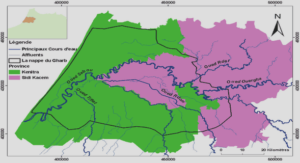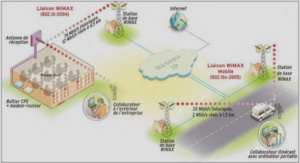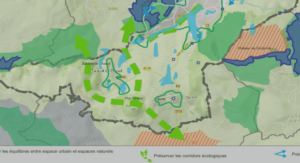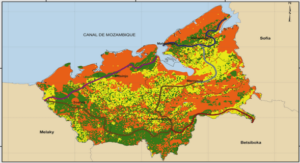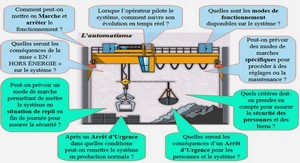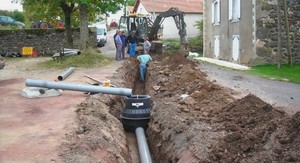Analyse InSAR des déformations de volcans actifs
Atmospheric contribution
Origin of atmospheric phase delay
In repeat-pass InSAR measurement, the two interferometric SAR images are not simultaneously acquired. The propagation path of radar signal for each acquisition can be affected differently by the atmosphere, resulting in a visible consequence on the interferogram. This undesirable part of contribution in interferometric phase is the so-called atmospheric contribution or atmospheric phase delay. The atmospheric contribution was first identified in 1994 (Massonnet et al, 1994), and quickly confirmed as the major limitation of InSAR accuracy for topographic reconstruction as well as for deformation monitoring. Rosen et al. (1996) found that the phase delay due to atmospheric refractivity anomalies can reach the level of 12 cm peak-to-peak in LOS direction obviously contaminating the deformation signal over Kilauea volcano, Hawaii. Zebker et al. (1997) reported that the spatial and temporal changes of 20% in relative humidity lead to 10 cm errors in deformation measurement, and perhaps 100 m of error in derived topographic products for those interferograms with unfavorable baseline geometries. The dominant source contributes to the atmospheric phase delay affecting the accuracy of InSAR measurement comes from the time and space variations of refractivity index in the neutral atmosphere, which is mainly confined to the troposphere (Goldstein, 1995; Massonnet & Feigl, 1995; Zebker et al., 1997; Hanssen, 2001). The refractivity index 𝑁 in the troposphere can be expressed as (Bean & Dutton, 1968; Thayer, 1974; Hanssen, 2001; Puyssegur et al., 2007; Doin et al., 2009): 𝑁 = 𝑘1 𝑃 𝑇 + (𝑘2 𝑒 𝑇 + 𝑘3 𝑒 𝑇 2 ) + 𝑘4𝑊𝑐𝑙 + 𝑘5 𝑛𝑒 𝑓 2 (2.20) Where 𝑃 = 𝑃𝑑 + 𝑒 is the total atmospheric pressure in Pa, 𝑃𝑑 is the partial pressure of dry air, 𝑒 is the partial pressure of water vapor in Pa, 𝑇 is the absolute temperature in Kelvin, 𝑊𝑐𝑙 is cloud water content in kg/m3 , 𝑛𝑒 is the electron density in the ionosphere and 𝑓 is electro-magnetic wave frequency, the constants 𝑘1, 𝑘2 … 𝑘5 are 𝑘1 = 0.776 K.Pa-1 , 𝑘2 = −0.06 K.Pa-1 , 𝑘3 = 3.75×103 K 2 .Pa-1 , 𝑘4 = 1.45×103 m3 .kg-1 , and 𝑘5 = −4.03×107 s -2 .m3 (Smith & Weintraub, 1953; Skone & Cannon, 1999; Solheim et al., 1999). The tropospheric phase delay 𝜙𝑡𝑟𝑜𝑝, at a specific height, 𝑧 = 𝑧0, corresponds to the integration of the refractivity between 𝑧0 and the top of the troposphere 𝑧𝑡𝑜𝑝 along the radar LOS (Hanssen, 2001). 𝜙𝑡𝑟𝑜𝑝 = −4𝜋 𝜆 10−6 (cos 𝜃) −1 ∫ 𝑁(𝑧)𝑑𝑧 (2.21) 𝑧=𝑧𝑡𝑜𝑝 𝑧=𝑧0 Where 𝜃 is the incidence angle, 𝜆 is the radar wavelength, and −4𝜋 𝜆 is a conversion factor to convert from range increase to phase delay. The first term at the right-hand side of the Equation is often called “hydrostatic term” that corresponds to the effect of dry air and a partial effect of water vapor on refractivity. The second and the third term (in brackets) are the “wet term” related to the rest effect of water vapor contained in troposphere. The fourth term refers to the effect of liquid water contained in the clouds that the radar signal passes through, and the fifth term corresponds to the dispersive effect of ionosphere. The “hydrostatic delay” yielded by the hydrostatic term has a very limited influence on interferograms, and can be safely ignored in case of about 50 km and smaller of interest area. Whereas, the wet terms, parametrized by temperature 𝑇 and the partial pressure of water vapor 𝑒, is much more spatially variable then the hydrostatic term. The variations of the wet delay have a considerable effect on the observed phase delay. Bean & Dutton (1968) and Hall et al. (1996) reported that the effect of liquid water in clouds on atmospheric delay rarely exceeds 1 mm/km along the LOS direction. Thus this part is sometimes neglected when computing the perceptible water vapor, which however will result in an overestimation of less than 10% (Hanssen, 2001). Jolivet et al. (2014) nevertheless suggests that the hydrostatic delay should not be neglected because it accounts for about 15% of the variance reduction when surface temperature varies by more than 10 °C during the year. Ionospheric delay is electro-magnetic wavelength dependant (Equation 2.20) and L-band data are more affected by ionospheric effects than X or C-band data. Based on current theoretical considerations and experimental results, the hypothesis that, the ionospheric effect may induce long wavelength signals over a single SAR image but will not noticeably affect phase variations at spatial scales less than about 50 km (in particular for studies using C-band sensors), is currently adapted (Hanssen, 2001; Raucoule & De Michele, 2010).
Distribution of tropospheric phase delay
From the point of InSAR applications, the total tropospheric phase delay results from the combined effects stratification of the lower troposphere (called stratified delay) and turbulent mixing in the troposphere (called turbulent delay) (Hanssen, 2001; Emardson et al., 2003; Doin et al., 2009; Jolivet et al., 2014). On a single SAR image, the tropospheric contribution can be expressed as (Doin et al., 2009): 𝑁(𝑥, 𝑧) = 𝑁̅(𝑧) + 𝛿𝑁(𝑥, 𝑧) (2.22) Where 𝑁̅(𝑧) is the average vertical stratified component of the image, 𝛿𝑁(𝑥, 𝑧) denotes the deviation from the average profile, implying the local turbulent component at location 𝑥, and 𝑧 is related to the elvation. The turbulent component is due to the laterally variable turbulence of the troposphere or clouds, locally modifying the propagation speed of the radar wave. On the interferograms, it is reflected by a random signal (random in space and time) comparable to a medium extent of noise. Figure 2.21a shows an example of phase delay due to the turbulent mixing in troposphere. The temporal baseline is 24 days, and the perpendicular baseline is 33 m. The area extends from the west boundary of Enclos Fouqué Caldera to the sea. No ground displacement is expected to occur during this period. The contour is superimposed on the map. According to the Figure 2.21c, no clear correlation between interferometric phase and elevation is visible over the whole interferogram. Figure 2.21 Example of two types of tropospheric phase delay. (a) A CSK interferogram spanning 24 days showing the turbulent component of tropospheric phase delay, and its correlation with topography showing in (c). (b) A CSK interferogram spanning 16 days showing the stratified component of tropospheric phase delay, and its correlation with topography showing in (d). The stratified component results from vertical variation refractivity index of the troposphere. Temporal variations in the vertical stratification component lead to a phase delay within the interferometric phase that correlates with topography. Figure 2.21b shows an example of interferogram with stratified tropospheric delay. We estimate as well the coefficient of correlation between interferometric phase and elevation (Figure 2.21d). The phase-elevation plot reveals the clear correlation between phase and topography.
Tropospheric delay correction methods
Since the turbulent tropospheric delay is randomly distributed in time and space, it cannot be modeled, but it is possible to calculate the statistical characteristics of this random signal. In practice, we consider that the turbulent delay can be corrected by multiple InSAR processing, such as interferograms stacking (Zebker et al., 1997; Lasserre et al., 2007) and InSAR time series ananlysis (Ferretti et al., 2001; Cavalié et al., 2007). The stratified delay has a temporally varying amplitude and sign as well, suggesting it should also be mitigated by interferograms stacking or by smoothing InSAR time series. However, it is clearly less efficient than for turbulent delay, as the stratified delay is not random in time but sometimes presents seasonal fluctuations, and its spatial pattern always mimics elevation (Doin et al., 2009). Therefore, properly estimation and correction of the stratified tropospheric delay is the main task for most InSAR studies. Numerous methods focusing on the quantification and correction of the tropospheric delay from InSAR measurements have been proposed since 1990s. Those proposed methods can be divided into two groups, interferometric phase-independent methods and interferometric phase-dependent methods, relying on the dataset used for estimation of tropospheric delay. The interferometric phase-independent methods work on the external datasets to compute synthetic tropospheric delay for corresponding interferogram and correct it directly. Numerous correction methods have been developed based on various external datasets, such as, (1) using Zenith Wet Delay (ZWD) data obtained from a network of Global Navigation Satellite System (GNSS) receivers in the area imaged by SAR (e.g. Williams et al., 1998; Webley et al., 2002; Li, 2005; Li et al., 2006a; Onn & Zebker, 2006); (2) using Medium Resolution Imaging Spectrometer (MERIS) and/or Moderate Resolution Imaging Spectroradiometer (MODIS) data to analyze the magnitude and behavior of the water vapor variation that is considered as the main contribution to the tropospheric delay (e.g. Li, 2005; Li et al., 2006b, 2009, 2012a; Remy et al., 2011, 2015); (3) using Global Atmospheric Models (GAM, that provides estimates of temperature, water vapor partial pressure, and geopotential height of pressure levels, on a regular spatial grid at regular time steps) to predict delays at the time of SAR acquisitions and correct for the stratified tropospheric delays in SAR interferograms (Doin et al., 2009; Jolivet et al., 2011, 2014). The GAM models includes ERA-Interim (European Center for Medium-Range Weather Forecasts, ECMWF) (Dee et al., 2011), the North American Regional Reanalysis (NARR) (Mesinger et al., 2006), and the Modern Era-Retrospective Analysis for Research and Applications (MERRA) (Rienecker et al., 2011); and (4) using a combination of (1) and (2) (Puysségur et al., 2007), or of (2) and (3) (Walters et al., 2013). These methods, although can reduce the tropospheric delay in interferograms, they are often limited by the spatio-temporal collection of the corresponding external datasets since they are not always available for the time of each SAR acquisition (especially unlikely for InSAR time series studies) and the low spatial resolution is often not qualified for high accuracy InSAR measurements. The interferometric phase-dependent methods use only the interferometric phases and the topography of the study area. It is based on the analysis of the phase delay to elevation relationship observed in individual interferograms (e.g. Beauducel et al., 2000; Remy et al., 2003; Taylor & Peltzer, 2006). The phase/elevation correlation 𝜙𝑡𝑟𝑜𝑝 = 𝑓(𝑧) can be linear or nonlinear varying from case to case. A simple linear empirical function can be expressed as: 𝜙𝑡𝑟𝑜𝑝 = 𝐾𝑡𝑟𝑜𝑝𝑧 + ∆𝜙0, where 𝐾𝑡𝑟𝑜𝑝 is a constant to be estimated and used to model the tropospheric delay throughout the interferogram, and ∆𝜙0 represents a constant shift. The phase-dependent methods based on empirical functions are uncomplicated and efficient to synthesize the stratified tropospheric delay with no need for collecting external datasets (that sometimes is difficult or even inaccessible). Despite all advantages, these methods have several limitations. First, this method is only applicable when a non-deformation area is available or the expected deformation signal do not correlates with topography. If deformation is expected to be present throughout the whole interferogram and to correlate with topography, such as over volcanoes or areas with wide range of topography (e.g. Delacourt et al., 1998; Elliott et al., 2008), the use of a priori deformation model is needed to pre-separate different contributing signals (e.g. Cavalié et al., 2008; Chapter 4). Alternatively, Lin et al. (2010a) developed an approach that can be applied in a deforming area by using the insensitivity of a spatial frequency band to deformation. This method assume the empirical phase-elevation relationship holds for all spatial frequencies, but the deformation may only be significant in a certain frequency. The second limitation that using one single phase-elevation relationship over the whole interferogram sometimes results in inaccurate estimates due to the spatial variation of the stratified troposphere. This can be significant when a large area, say larger than tens of kilometers, is studied. To solve this problem, Bekaert et al. (2015) proposed and tested a novel power law correction method which can be applied in the presence of deformation, over a range of different time periods and in different atmospheric conditions. All currently proposed methods for tropospheric delay correction are evidenced successful in corresponding cases, but few can be universally applicable. Their performance can vary from case to case and should be carefully evaluated for each. In this dissertation, we applied the phase-independent method based on MERIS and MODIS near-infrared water vapor products to estimate the tropospheric delay in the InSAR data acquired over the Llaima volcano in Chile, which will be detailed in Chapter 7. We proposed a phase-dependent tropospheric correction method for the specific case of Piton de la Fournaise volcano in La Réunion Island. It is based on an a priori deformation model which is extracted by a principal component decomposition implemented in Principal Component Analysis-based Inversion Method package .
ABSTRACT |

